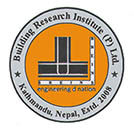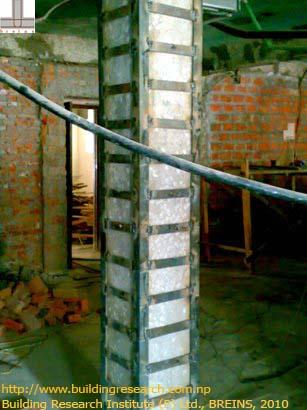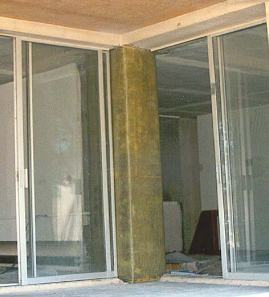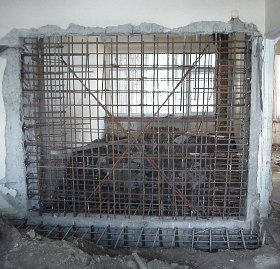
Today (NST)
Monday, Jun 16, 2025
Smart Search
Please post in your Technical Queries, Comments & Suggestions to Contact us......
Advertisement

For Advertisement
|
|
| Subscribe to BREINS Sci-Tech |
| Visit this group |

Seismic Retrofitting
Retrofitting of Reinforced Concrete (RC) Frame Structures
Retrofitting options for Reinforced Concrete (RC) frame structures are more complicated and may be costlier than for the structures with a load bearing wall system. Behavior of the frame structured system is entirely different from load bearing wall structures; thereby demanding a different approach.
Several Retrofitting Techniques are available to strengthen the seismically deficient RC Frame Structures as presented below;
Jacketing of Structural Members
Addition of Extra Structural Members
Addition of Energy Dissipation Devices
Among the above three, first two methods are conventional methods (except Jacketing by FRP) whereas the later one (Addition of Energy Dissipation Devices) is a modern approach and rather sophisticated one.
Jacketing of Structural Members
Various Jacketing techniques are available for the strengthening of deficient structural members as mentioned below;
Fibre Reinforced Polymer Jacketing
Conventional Jacketing methods primarily include Jacketing of various structural members by Reinforced Concrete or Steel works; respectively known as Concrete Jacketing & Steel Jacketing.
Modern Jacketing techniques use Fibre Reinforced Polymer (FRP) sheets that have much higher strength than steel for enhancing the strength of deficient members.
These Jacketing methods basically impart extra confinement to the existing members and enhancement in shear & flexural capacities too, if properly designed & implemented.
Enlargement of the existing structural members such as Column/Beam sections by placing reinforcing Steel Rebars around its periphery and then concreting it is widely adopted option; which is referred as Conrete Jacketing. Following presents (Fig-5) the technique of Concrete Jacketing being applied on the RC Column.

Fig-5 (Strengthening of the existing Column by providing Rebars around its periphery for Concreting; known as Concrete Jacketing)
This method significantly increases the member sizes and thereby its Stiffness. Concrete Jacketing primarily enhances the Confinement along-with the Shear & Axial behavior incase of Columns; whereas in deficient RC Beams, it improves Shear and Flexural behavior too.
Jacketing of Columns & Beams with Steel Angles, Channels and Bands (Fig-6) is another conventional technique of retrofitting known as Steel Jacketing.

Fig-6 (Retroffiting of the Weak Column using Steel Angles and Bands, known as Steel Jacketing. Designed and applied by BREINS Structural Care. Pic Courtesy : Building Research Institute (P) Ltd., Nepal)
Though this method doesn't much increase the Column sizes relative to Concrete Jacketing, nevertheless, increase in stiffness could be significant.
Fibre Reinforced Polymer (FRP) Jacketing
In Jacketing of structural elements, modern techniques are also available that use Fibre Reinforced Polymer (FRP) sheets for enhancing the strength of deficient members.
Fibre Reinforced Polymer based composite materials as Carbon Fiber Reinforced Polymer (CFRP) and Glass Fibre Reinforced Polymer (GFRP) have shown a great promise in the rehabilitation of reinforced concrete (RC) structures. Retrofitting of structures can be done with much ease using these high strength sheets (Fig-7). Composite materials are an excellent option to be used as external reinforcing because of their high tensile strength, lightweight, resistance to corrosion, high durability, and ease of installation.

Fig-7 (Retrofitting of the RC Column by wrapping around with Carbon Fibre Reinforced Polymer, CFRP wrapping)
Externally bonded CFRP reinforcement has shown to be applicable in the strengthening of many types of RC structures such as Columns (Fig-7), Beams, Slabs, Walls, Tunnels, Chimneys, and Silos, and can be used to improve their flexural and shear capacities, and also provide confinement and ductility to compression structural members.
Addition of Extra Structural Members
Inclusion of reinforced concrete Shear Walls possibly in between the Columns (Fig-8) thereby developing the strong alternative load path is another method that requires less disturbance in the existing building as the work is confined at the particular location only.

Fig-8 (Construction of the Reinforced Concrete Shear Wall as a Retrofitting measure)
In this method only shear wall is added right from the foundation level and there may be no need to strengthen other structural components. Instead of RC shear walls, steel bracings could also be used.
Addition of Energy Dissipation Devices
Installation of Energy Dissipation Devices such as shock absorbers, a rather sophisticated method is an highly effective approach in seismic retrofitting of deficient structures. Please refer (http://buildingresearch.com.np/erd/erd7.php) to learn on Energy Dissipation Devices.
Energy Dissipation Devices are basically Passive Seismic Control Systems. Viscous Fluid Dampers and Tuned Mass Dampers both of which are Passive Seismic Control System are gaining popularity in Seismic Retorfitting of the Buildings and Bridges too. Addition of Energy Dissipation Devices has shown a great promise in the field of Seismic Retrofitting.